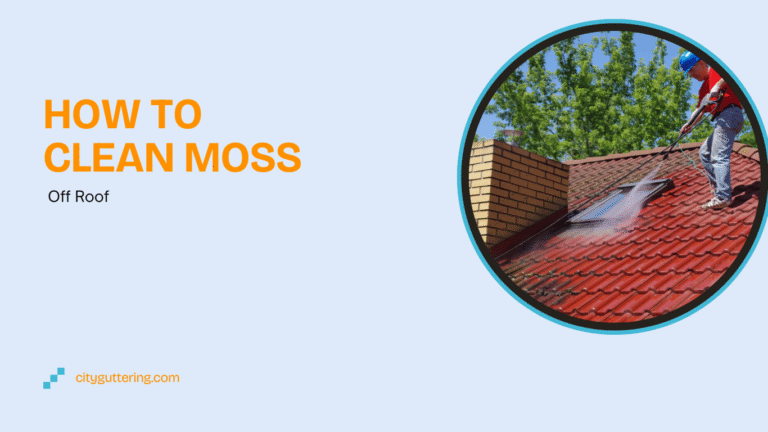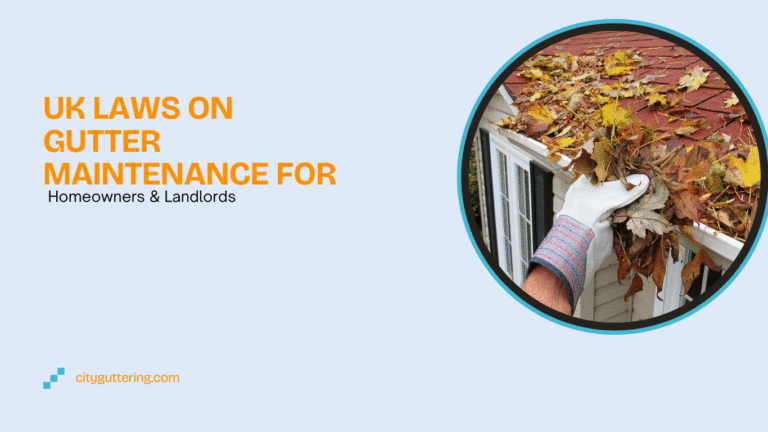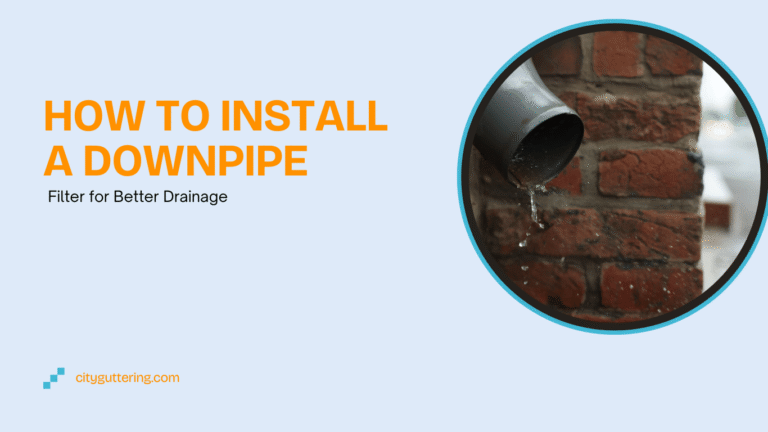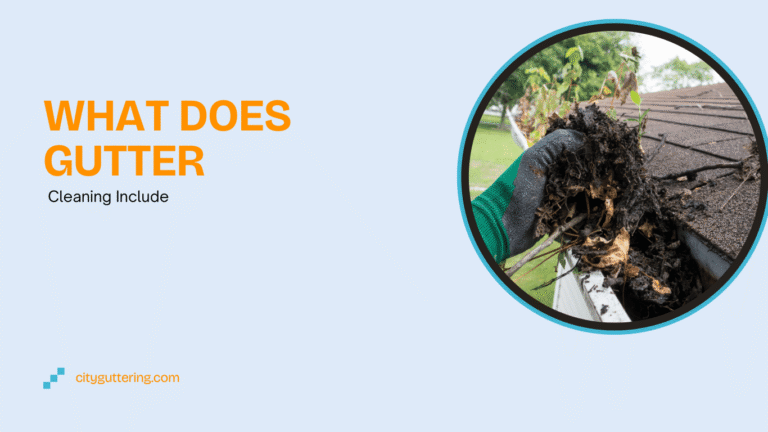Guttering might seem like a simple part of your property, but when it goes wrong, the consequences can be frustrating and expensive. One of the most important factors in a properly functioning gutter system is slope.
Does Guttering Need To Slope? Guide for Homeowners
Without the right slope, even the cleanest gutters can fail to move water effectively away from your home. But how much slope is enough? And what happens if it’s wrong?
Let’s break it down in simple terms.
Why Gutter Slope Matters
Gutters aren’t just long metal troughs attached to the edge of your roof. They’re designed with a purpose: to collect rainwater and direct it away from your building. But gravity doesn’t work well without the right setup. This is where slope or “fall” comes in.
When gutters slope correctly, water naturally flows towards the downpipe. If they’re level or sagging in the wrong direction, water sits still. And standing water in gutters is a recipe for trouble.
Here’s what can happen when gutters don’t slope properly:
- Water overflows and damages walls, windows, or foundations
- Gutters sag under the weight of stagnant water
- Algae, moss, and insects thrive in wet spots
- Ice can build up in winter, worsening gutter damage
For properties in places like South London and Surrey, where rainfall is regular, these issues can develop fast if ignored.
How Much Slope Should Gutters Have?
The general rule used by professional gutter installers is a minimum of 1/4 inch slope for every 10 feet of guttering. This means the gutter should drop slightly from one end to the downpipe so water can drain without resistance.
To visualise it:
- For a 20-foot run of gutter, there should be a 0.5-inch drop toward the outlet
- This drop is subtle it won’t be obvious from the street, but it makes a big difference
Too much slope, however, isn’t helpful either. Water might rush down too fast, missing the downpipe or leaving dry spots. Too little, and you’re left with puddles. Getting the balance right takes a trained eye and accurate measuring tools.

Common Signs of Poor Gutter Slope
You don’t always need to climb up a ladder to know something is wrong. Some signs of improper slope are easy to spot from the ground or during a rainstorm.
Look out for:
- Water pooling inside the gutters even when it’s not raining
- Overflowing water during light or moderate rainfall
- Sagging sections of gutter that appear lower than the rest
- Water stains on walls or fascia boards
- Plants or moss growing inside your gutters (a sign water isn’t moving)
If your property in Central London, South West London, or surrounding areas shows any of these symptoms, it’s time to inspect the slope or call in a professional for an assessment.
Why Gutters End Up with the Wrong Slope
Improper slope doesn’t always mean poor workmanship. Over time, several factors can cause gutters to lose their proper alignment.
Here are the usual culprits:
- Aging brackets or hangers: These can loosen over time, letting sections dip
- Clogged debris: Wet leaves and muck can weigh gutters down and pull them out of alignment
- Building movement: Older homes settle over time, affecting gutter angle
- DIY repairs: Fixes without a level or proper tools may throw off the balance
- Heavy snow or ice: These can physically bend or warp gutter sections
Older homes across Surrey and Hampshire are especially prone to slope issues due to roofline quirks and natural building shifts.
How to Check If Your Gutters Are Sloped Properly
You can do a basic slope check yourself, though it’s best left to a professional if you’re unsure.
DIY Check Method:
- Use a ladder safely and access a visible section of the gutter
- Place a spirit level inside the gutter, along its length
- Check that the bubble leans slightly toward the downspout
- Pour a small amount of water and see if it flows quickly toward the outlet
Warning: Never climb up if the weather is wet or windy, and always use proper ladder support.
If you’re not confident or the slope looks wrong, our team at City Guttering London offers fast telephone inspections and can be on-site quickly with the tools to assess it properly.

Fixing Gutter Slope Problems
The solution depends on the severity of the issue. Sometimes, a small adjustment is all that’s needed. Other times, a full realignment is required.
Here’s how slope problems are usually resolved:
- Adjusting or replacing brackets: Reattaching them at the correct angle
- Re-pitching the gutter run: Removing sections and reinstalling them correctly
- Clearing debris: Sometimes slope appears wrong due to heavy blockages
- Replacing warped sections: Especially with old metal or plastic gutters
At City Guttering London, we assess slope as part of every cleaning and maintenance visit. This way, small problems are fixed before they turn into serious repairs.
Ongoing Maintenance to Prevent Slope Issues
Proper gutter slope isn’t a “set and forget” job. Regular care is important for keeping everything working as it should. Especially with the unpredictable rain patterns in Greater London and the tree-lined streets of Surrey.
Our top maintenance tips:
- Schedule gutter cleaning at least twice a year, especially before winter
- Inspect brackets and hangers after heavy storms
- Check for blockages in downpipes
- Book a yearly inspection, especially for older properties
- Avoid DIY cleaning unless you’re experienced and have the right gear
For customers in South West London, Surrey, and Hampshire, we recommend pre-autumn and post-winter check-ups. This is when most clogs and slope shifts occur due to leaf fall and freezing temperatures.
Why the Right Slope Matters in London Properties
London buildings are a mix of architectural styles Victorian terraces, modern flats, and converted commercial spaces. Many have complex rooflines, long gutter runs, or flat roof sections that demand careful planning. The wrong slope in any of these can result in:
- Damage to historic fascia boards
- Water ingress through parapet walls
- Basement damp issues from poorly drained rainwater
- Leaks into shopfronts or office ceilings
In commercial properties, poor drainage can mean unhappy tenants or service downtime. In residential homes, it’s often the start of bigger structural problems.
That’s why we treat slope issues as a priority not an afterthought when repairing or replacing gutters.

When to Call a Professional Guttering Company
If you notice signs of poor water flow, standing water, or staining, don’t wait for it to worsen. Checking gutter slope is part of routine maintenance for us at City Guttering London.
What we offer:
- Instant telephone inspections to identify the issue
- Free quotes within 45 minutes
- Fast emergency repair services in London and surrounding counties
- Gutter realignment and full replacement when required
- Scheduled maintenance plans for hassle-free upkeep
Whether you live in South London or manage a building in Central London, our team can inspect and correct slope issues quickly and professionally.
Final Thoughts
So, does guttering need to slope? Absolutely. Without the right fall, water won’t flow properly, which leads to expensive damage, not just to your gutter system but to your entire property.
Maintaining the correct slope is a small but essential part of keeping your home or business in good shape. And with expert help from City Guttering London, it’s easier than you think.





